ANIMALS
Meet the Extraordinary Tiny Hummingbird with an Amazing Spiky Orange Crest

These plump-winged creatures are some of the most stunning and beautiful animals living in the forests of South America. Due to their small size and limited population, they are a rare and remarkable sight to behold. Allow me to introduce you to the rufous-crested coquette (Lophornis delattrei), a type of hummingbird native to the lush slopes of Pacific South America!
What sets the rufous-crested coquette apart? It’s the enchanting crown that only the male members of this hummingbird species possess. They have marvelous spiky orange crests and feathers with black tips. The rest of their body is mostly green, with a dark throat and a distinctive white band across the rump.
Adult male
 Image source: Peter Hawrylyshyn, Waqanki Feeders, San Martín, Peru
Image source: Peter Hawrylyshyn, Waqanki Feeders, San Martín, Peru
Adult male
 Image source: graichen & recer, Canopy Lodge, Coclé, Panama
Image source: graichen & recer, Canopy Lodge, Coclé, Panama
Female/immature male
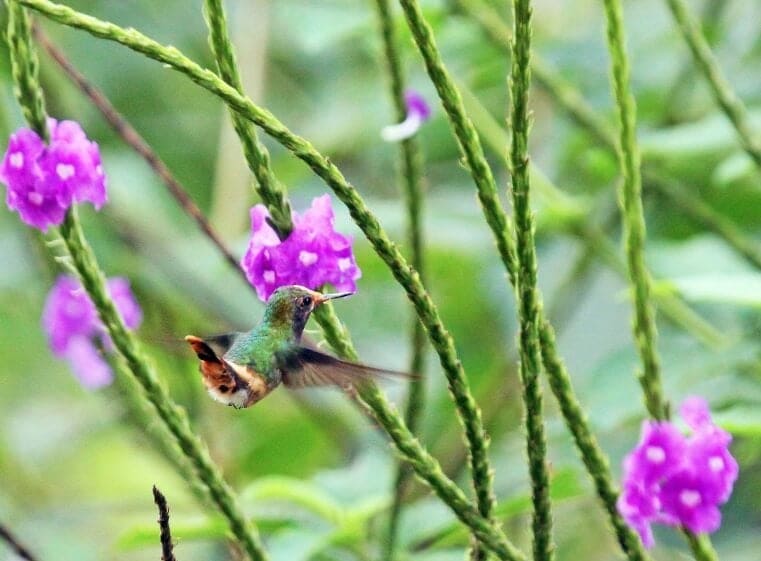 Image source: Johan Chaves, Rancho Naturalista, Cartago, Costa Rica
Image source: Johan Chaves, Rancho Naturalista, Cartago, Costa Rica
Females, although not as easily noticeable, can be recognized by their smaller size and the reddish-brown color on their foreheads and throat. They also have a white band across their lower back.
Adult male
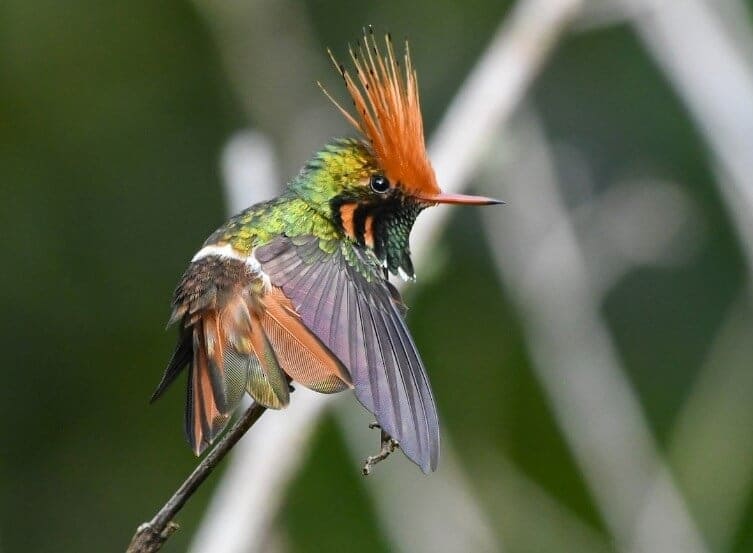 Image source: Ben Sanders, Reserva Arena Blanca, San Martín, Peru
Image source: Ben Sanders, Reserva Arena Blanca, San Martín, Peru
Adult male
 Image source: Jesse Huth, Waqanki/Quebrada Mishquiyaquillo, San Martín, Peru
Image source: Jesse Huth, Waqanki/Quebrada Mishquiyaquillo, San Martín, Peru
Female/immature male
 Image source: Brian Sullivan, Amazonía Lodge, Madre de Dios, Peru
Image source: Brian Sullivan, Amazonía Lodge, Madre de Dios, Peru
Rufous-Crested Coquettes are very small, measuring about 2.5 to 2.8 inches in length. Their wingspan is approximately 1.6 to 1.8 inches, and they weigh around 0.1 ounce on average. They are such adorable little creatures!
Female
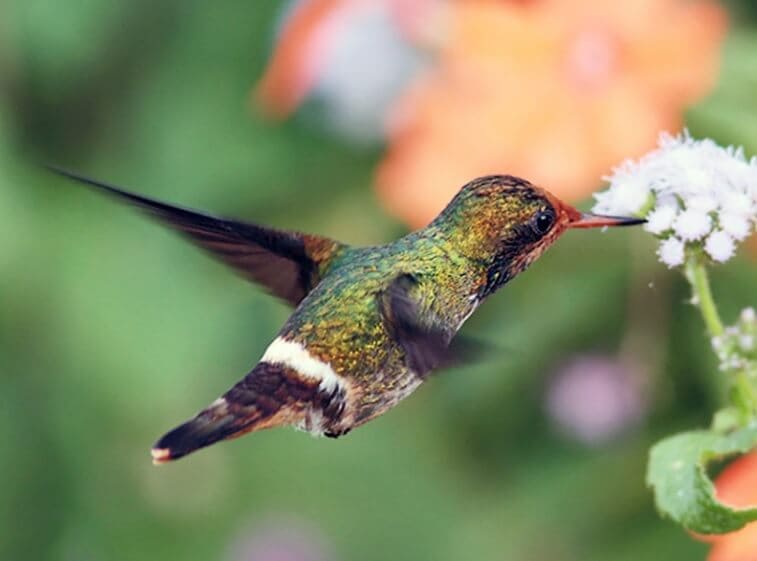 Image source: CELINE LAHAYE, Cerro Azul–Casa Colibrí, El Torreón, Panamá, Panama
Image source: CELINE LAHAYE, Cerro Azul–Casa Colibrí, El Torreón, Panamá, Panama
Foraging nectar
 Image source: Jon Pleizier, Canopy Lodge, Coclé, Panama
Image source: Jon Pleizier, Canopy Lodge, Coclé, Panama
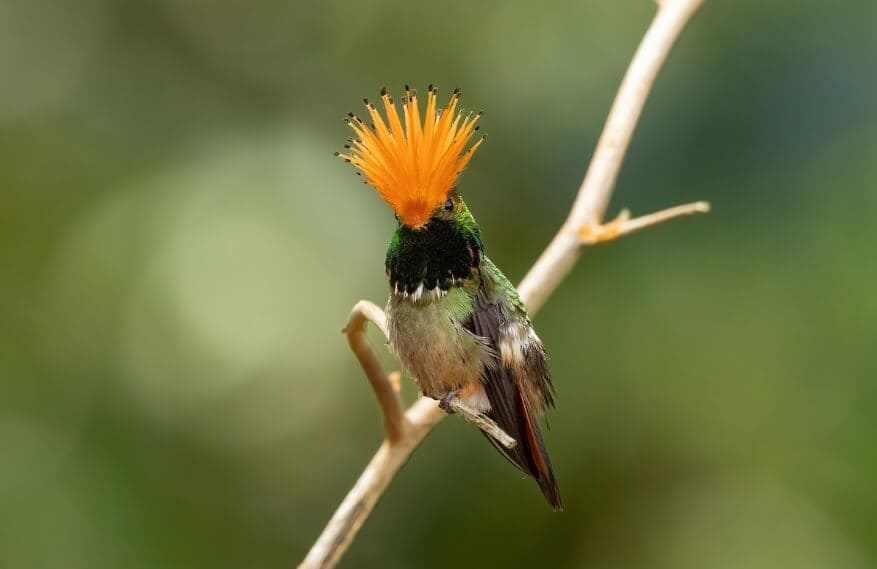 Image source: Thibaud Aronson, Waqanki/Quebrada Mishquiyaquillo, San Martín, Peru
Image source: Thibaud Aronson, Waqanki/Quebrada Mishquiyaquillo, San Martín, Peru
These hummingbirds like to search for food in areas with few trees. You can often find them near small flowers that are white in color. They enjoy drinking the sweet nectar from these flowers. They also catch insects by flying and catching them in mid-air.
When male Rufous-Crested Coquettes want to impress a female, they perform a special flying dance. They fly back and forth in front of the female while showing off their fancy crest.
A male rufous-crested coquette with its crest raised, perched on a branch. This photo was captured in an area where hummingbird feeders were placed, and this particular bird had a favorite spot that it guarded.
 Image source: Robert Lewis, Waqanki/Quebrada Mishquiyaquillo, San Martín, Peru
Image source: Robert Lewis, Waqanki/Quebrada Mishquiyaquillo, San Martín, Peru
11.
 Image source: Thibaud Aronson, Waqanki/Quebrada Mishquiyaquillo, San Martín, Peru
Image source: Thibaud Aronson, Waqanki/Quebrada Mishquiyaquillo, San Martín, Peru
Immature one
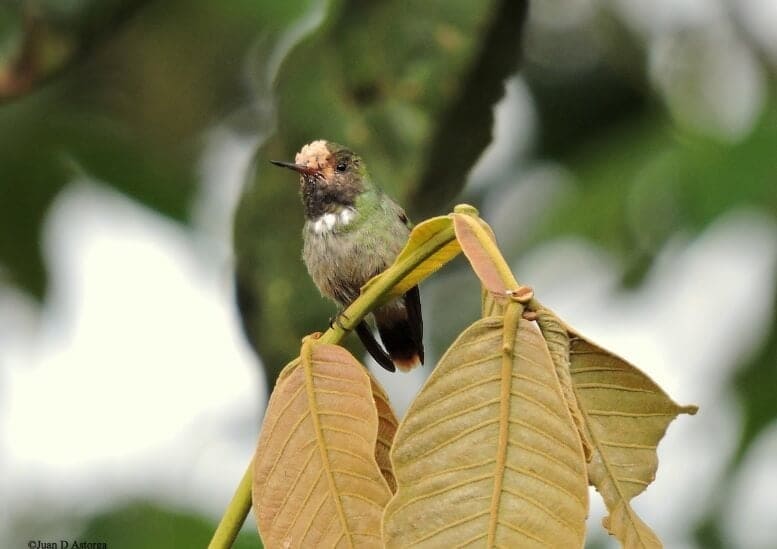 Image source: Juan D Astorga, Tuis, Turrialba, Cartago, Costa Rica
Image source: Juan D Astorga, Tuis, Turrialba, Cartago, Costa Rica
So Stunning
 Image source: Thibaud Aronson, Waqanki/Quebrada Mishquiyaquillo, San Martín, Peru
Image source: Thibaud Aronson, Waqanki/Quebrada Mishquiyaquillo, San Martín, Peru
When Coquette hummingbirds fly, you may notice their tails moving up and down like sphinx moths. Rufous-crested coquettes are usually quiet, but sometimes they make a quick “tsip” sound when they are drinking nectar or making soft chipping noises. Their wings flap very fast, creating a soft humming sound as they fly.
The rufous-crested coquette is a rare bird, but its population seems to be doing well. It is not considered to be in immediate danger, according to the IUCN red list.
Very beautiful
 Image source: imgur
Image source: imgur
 Image source: imgur
Image source: imgur
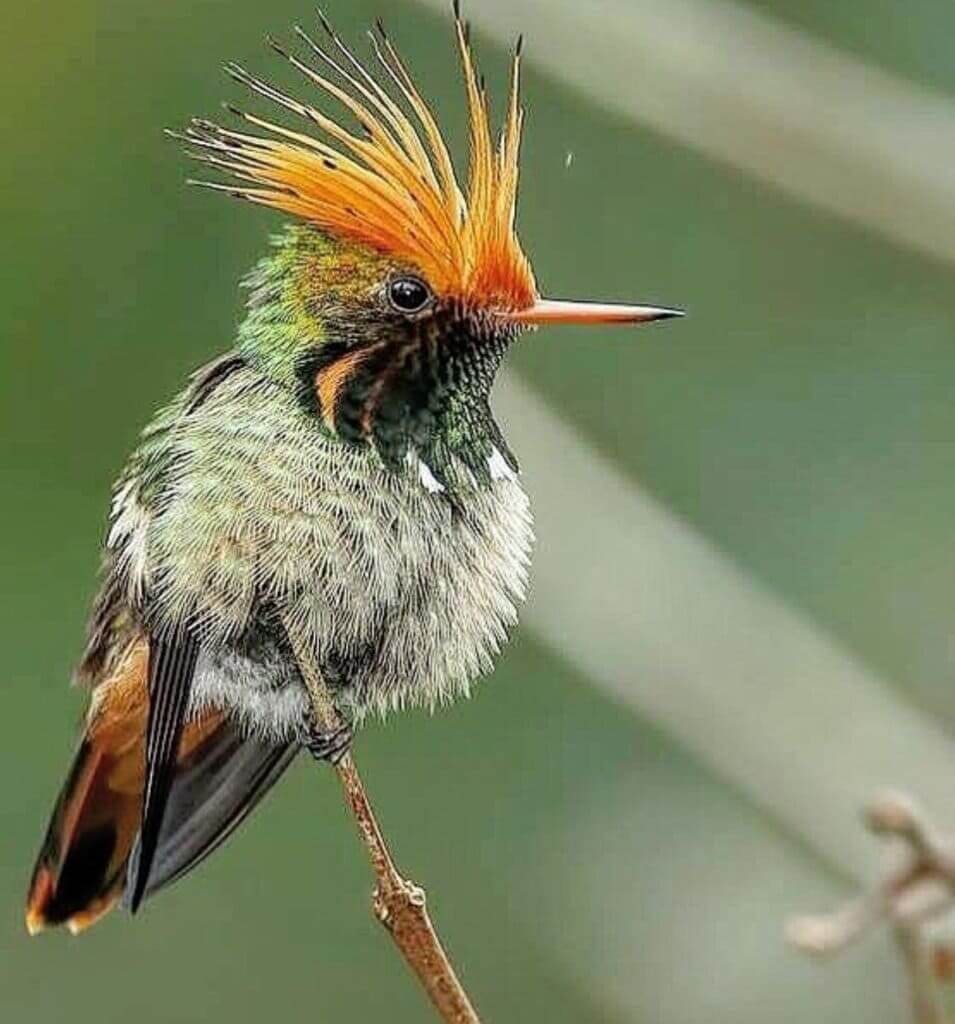 Image source: imgur
Image source: imgur
If you’re interested in learning more about birds, please leave a comment below, like and share this post, and visit our homepage for more fascinating content! We value your support and hope you have a great time exploring the world of birds!
ANIMALS
Amazing Video of Unseen Ocean Creatures in the Ningaloo Canyons

The Schmidt Ocean Institute recently explored the Ningaloo Canyons on the western coast of Australia using a robotic underwater vehicle called the ROV Sebastian. Check out the amazing video of what they discovered in the deep parts of the Indian Ocean.
More info: Youtube




ANIMALS
These Pics Are Art and the Artists Are Insects

Flying insects move so quickly that they are hard to follow, but new technology and some smart ideas have helped Spanish photographer Xavi Bou do just that. After spending 10 years focusing on birds in flight for his Ornithographies project, he turned his attention to insects.
For Entomographies, he uses high-speed video footage taken by Adrian Smith, an insect expert at North Carolina State University, to study and record how insects move. Bou then picks multiple frames and combines them into single images that show the fast movements of one or more insects through space and time.
With Smith’s help, Bou has captured the aerial tricks of wasps, the jumps of leafhoppers, and the fluttering of butterflies in amazing detail. He hopes that by doing this, he can make people more aware of the decline in important insect populations around the world.
1. Zebra longwing
This butterfly, which is common in many areas of the Americas, really fits its name. It can fly very high with just a few flaps of its large wings.
 Image source: nationalgeographic
Image source: nationalgeographic
2. Two-lined spittlebug
This insect, which comes from the eastern United States, is often seen as a pest because it likes to eat grass. Its springy back legs can make it jump into the air like a rocket.
 Image source: nationalgeographic
Image source: nationalgeographic
3. Yellow-collared scape moth
Unlike most moths, this North American species flies during the day. Its shiny blue-black wings sparkle in the sunlight.
 Image source: nationalgeographic
Image source: nationalgeographic
4. Ailanthus webworm moths
These tropical moths have spread farther north in the U.S. Because of their larval host, the invasive tree of heaven, they are now one of the most common backyard moths in the country.
 Image source: nationalgeographic
Image source: nationalgeographic
5. Common stonefly
Mostly found in eastern North America, this insect starts its life as an underwater nymph in forested streams or rivers. Then it leaves the water, sheds its skin, and becomes an adult with wings.
 Image source: nationalgeographic
Image source: nationalgeographic
6. Green lacewings
Eighty-seven species of this insect have been found in the U.S. and Canada. Since they eat a lot of unwanted plant pests like aphids and mites, they are often used to naturally control these pests.
 Image source: nationalgeographic
Image source: nationalgeographic
7. Grapevine beetle
This insect, fittingly named, eats the leaves and fruit of grapevines, both wild and farmed, but it doesn’t do much damage to the plants. As a type of scarab beetle, it often flies in a curved path.
 Image source: nationalgeographic
Image source: nationalgeographic
8. Oak treehopper and green treehopper
Treehoppers are known for their uniquely shaped pronotum, the part behind their head, which often looks like plant parts to hide from predators. They can jump well thanks to special muscles.
 Image source: nationalgeographic
Image source: nationalgeographic
9. Banded orange
This brightly colored butterfly can be found from Mexico to Brazil. Before mating season, male butterflies look for mineral salts, sometimes even drinking salty fluids from the skin, eyes, and nostrils of other animals.
 Image source: nationalgeographic
Image source: nationalgeographic
10. Sapho longwing
Longwings can live for 6 to 7 months, longer than most butterflies. This type, found from Mexico to Ecuador, has shiny blue wings, which is why it’s also called the Sapphire longwing.
 Image source: nationalgeographic
Image source: nationalgeographic
ANIMALS
Eagle and Fox in an Epic Midair Battle Over a Rabbit, Were Captured by a Photographer

Wildlife photography often depends on the perfect combination of good timing and the right place.
That’s exactly what happened when Kevin Ebi, an experienced wildlife photographer, captured an incredible battle between a bald eagle and a red fox, both competing for a rabbit meal.
In a detailed blog post, Ebi shares the fascinating series of events that unfolded while he was photographing foxes in San Juan Island National Historical Park, located in Washington state.
Ebi noticed a lively group of eight fox kits as they began their hunting lessons. Suddenly, they spotted a rabbit, and a thrilling chase ensued. Eventually, one of the foxes emerged as the winner, proudly carrying the rabbit across the field.
 Image source: Kevin Ebi
Image source: Kevin Ebi
Ebi shares what happened at that moment: “As I followed the fox with my camera, a sudden bald eagle cry caught my attention. It was swiftly approaching, clearly aiming for the rabbit. I quickly focused on the fox, anticipating a quick turnover of events.”
To Ebi’s astonishment, instead of a quick surrender, the situation turned into a intense fight in the air.
The eagle used its power to lift the fox and rabbit high up in the sky. Even while airborne, the fox attempted to break free by swinging back and forth.
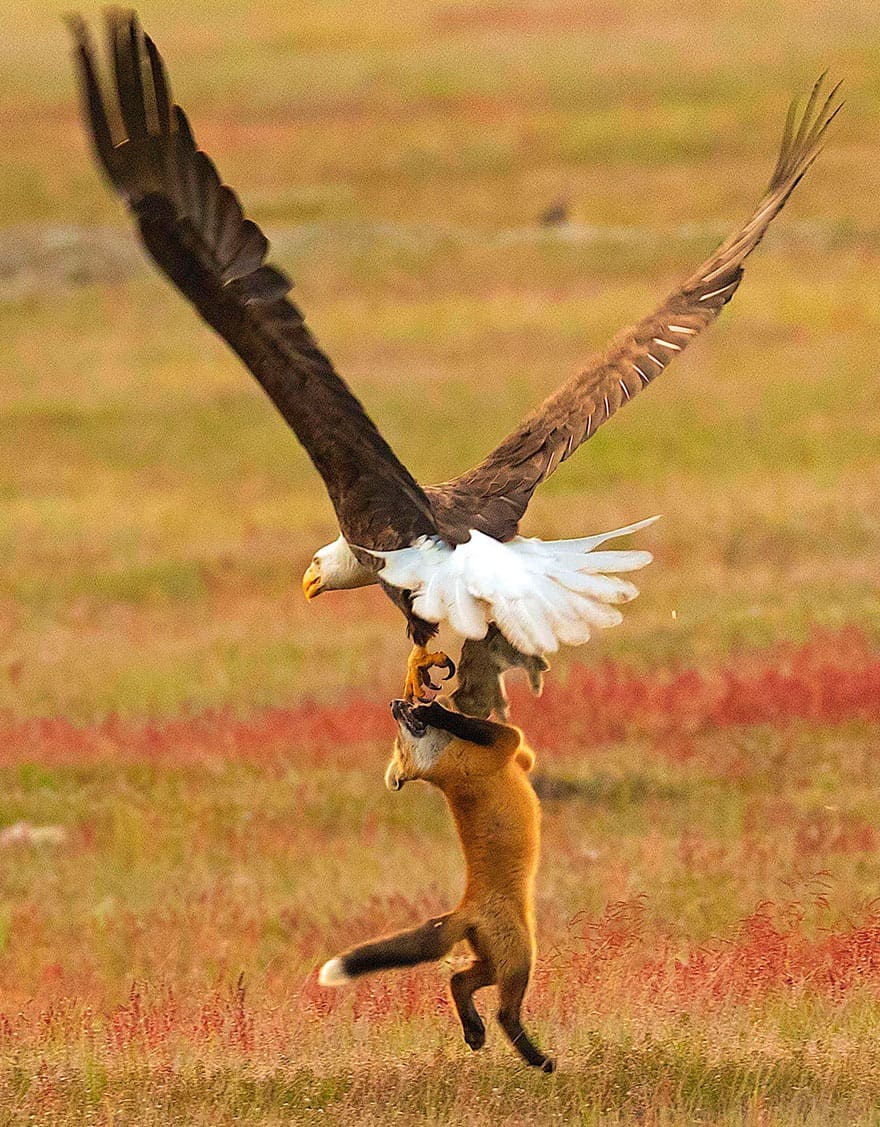 Image source: Kevin Ebi
Image source: Kevin Ebi
 Image source: Kevin Ebi
Image source: Kevin Ebi
 Image source: Kevin Ebi
Image source: Kevin Ebi
In the end, the eagle moved the rabbit to its other claw, causing the fox to let go. The intense battle came to an end in less than 10 seconds.
 Image source: Kevin Ebi
Image source: Kevin Ebi
For those worried about the fox’s well-being after the fight, Ebi reassures that it was not injured. The fox swiftly bounced back from the encounter and resumed its playful behavior with the other young foxes, showing no visible wounds from the aerial clash.
 Image source: Kevin Ebi
Image source: Kevin Ebi
 Image source: Kevin Ebi
Image source: Kevin Ebi
 Image source: Kevin Ebi
Image source: Kevin Ebi
 Image source: Kevin Ebi
Image source: Kevin Ebi
-

 GARDEN10 tháng ago
GARDEN10 tháng ago4 Easiest Ways to Get Free Plants
-

 ANIMALS10 tháng ago
ANIMALS10 tháng agoBritish Angler Caught Huge 67-Pound Goldfish in the World
-

 FUNNY10 tháng ago
FUNNY10 tháng ago30 Funny and Perplexing Photos That Make You Laugh All Day
-

 GARDEN9 tháng ago
GARDEN9 tháng ago30 Shimmering Side Yard Landscape Ideas
-

 FUNNY10 tháng ago
FUNNY10 tháng ago30 Weirdest Things That People Came Across On The Subway
-

 DIY & CRAFT10 tháng ago
DIY & CRAFT10 tháng ago19 Easy and Creative DIY Ideas to Enhance Front Yard
-

 ANIMALS10 tháng ago
ANIMALS10 tháng agoKindhearted Driver Rescues Skinny Dog Hiding Near Highway Thanks to His Eagle Eye
-

 FUNNY10 tháng ago
FUNNY10 tháng ago22 Design Fails That Will Make You Laugh Out Loud





